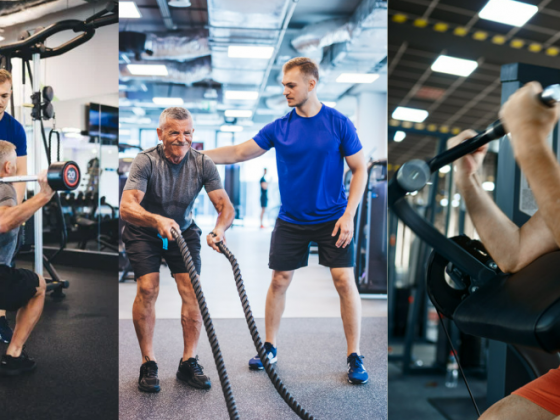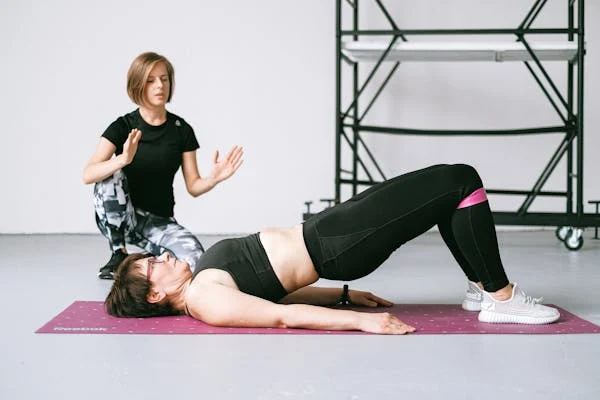
Round Butts are aesthetically good-looking and good for health—the reason most people set their body goals is to have lifted and well-rounded butts. Yet among the many options available, picking the right exercises along with eating well is vital to building a strong and healthy butt quickly and effectively. This article will help you with the best butt-lifting exercises to pair with your healthy diet and glutes goal.
What are the benefits of Butt-Lifting Exercises?
Adding specific workouts targeting your glutes to your exercise routine can alleviate lower back and knee discomfort, enhance posture, and make everyday activities more manageable.
The Best 5 Butt-Lifting Exercises:
Try out these five exercises designed to target your glutes from various angles. Strengthening your butt muscles is essential as they contribute to hip extension, abduction, and rotation, which are vital movements for overall lower body strength and stability.
Glute Bridges Exercises
The glute bridge is a foundational exercise where you lie on your back and lift your hips upward. This simple at-home movement requires no equipment and offers benefits such as enhanced glute strength, core stability, and improved lower back health.
The glute bridge is beneficial for strengthening the gluteus muscles and hamstrings. To perform it, lie on your back with your feet flat on the ground and lift your pelvis upward. This exercise aids in improving hip flexibility and lower back health. Especially useful for those with limited hip flexor mobility due to prolonged sitting, glute bridges also serve as an effective warm-up to enhance hip flexibility before workouts.
Try incorporating glute bridges into your workout routine, as they cater to all fitness levels and mimic the movement patterns of more complex exercises. Using a dumbbell, you can execute this exercise with a loop band or no equipment.
Here are four benefits of incorporating glute bridges into your workout routine:
- Strengthening the Glutes: Glute bridges engage all three gluteal muscle groups—maximus, medius, and minimus—simultaneously, promoting overall glute strength.
- Targeting the Hamstrings: In addition to the glutes, glute bridges effectively target the hamstrings, especially as you hold the bridge position for longer durations.
- Core Stabilization: Performing glute bridges requires core activation, contributing to improved posture, enhanced body strength, and better support for the lower back.
- Equipment-Free Exercise: Glute bridges can be done anywhere without specialized gym equipment, making them accessible and convenient for workouts. All you need is a flat surface and optional padding for comfort.
To perform the exercise, lie on your back with knees bent and arms at your sides, positioning a dumbbell across your hip crease if desired, and keeping feet 12–16 inches away from your butt. Pressing through your heels, engage your core, and raise your pelvis upward by squeezing your glutes while keeping your chest on the ground. Hold the lifted position for 2 seconds before gently lowering your hips, completing one repetition. Aim for 8–12 reps in 2–3 sets for optimal results.
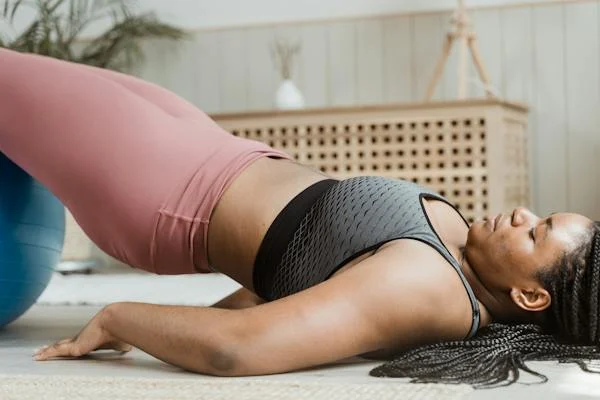
Hip Thrusts Exercises
The hip thrust, a hip thruster, is a lower-body exercise targeting the gluteal muscles, including the gluteus maximus, gluteus medius, and gluteus minimus. When performed correctly, hip thrusts engage muscles in the lower back and legs, such as the hamstrings, adductors, and quadriceps. While the barbell hip thrust is the standard variation, alternative versions utilize weights like dumbbells or kettlebells.
Hip thrusts rank among the top exercises for building and fortifying the glutes. For added comfort when using a barbell, consider using a barbell pad. Keep your chest steady throughout the entire motion, and concentrate on driving the movement with your pelvis. If you’re new to this exercise, practicing without a barbell is advisable. Before advancing to hip thrusts, you can start with glute bridges to perfect the technique.
Training the glutes through hip thrusts and bridges provides a multitude of advantages for general health and wellness:
- Improved Posture and Reduced Pain: Glute exercises help balance muscle groups, preventing postural issues like anterior pelvic tilt, which can lead to discomfort and pain. Strengthening the glutes also supports the spine during movement, reducing strain and risk of injury.
- Enhanced Bone Density: Weight-bearing exercises like hip thrusts promote bone development and preservation of bone density, preventing conditions like osteoporosis, especially in menopausal women.
- More accessible Daily Activities: Strong glutes support proper gait and balance, making walking, climbing stairs, and running more efficient and comfortable. Glute exercises also enhance stability and mobility, improving overall functional movement patterns.
- Glutes Linked to Pelvic Floor Health: Glutes play a role in stabilizing the sacrum and balancing against the pelvic floor muscles, promoting optimal pelvic alignment and function. Weak glutes can contribute to lumbar tightness and posture issues.
- Enhanced Mobility and Speed: Strong glutes enhance athletic performance by improving movements like jumping, accelerating, decelerating, and rotational throwing. Strong glutes also aid in injury prevention and optimize technique in various exercises and sports movements.
To perform hip thrusts, begin by positioning yourself on the ground with your shoulder blades resting against a surface against a secured bench, either against a wall or anchored to the floor. Sit with your legs straight and a barbell positioned across the crease of your hips, gripping the bar with your hands, or opt for a dumbbell. Bend your knees, ensuring your feet are hip-width apart. Drive your heels into the ground, engage your core, and lift your pelvis upward by contracting your glutes.
At the movement’s peak, your lower legs should be perpendicular, your upper body should be parallel to the ground, and your knees should be bent at a 90-degree angle. Avoid relying on your lower back for the lift. Slowly lower the weight back down. Aim for 8–12 repetitions across 2–3 sets to optimize your workout.
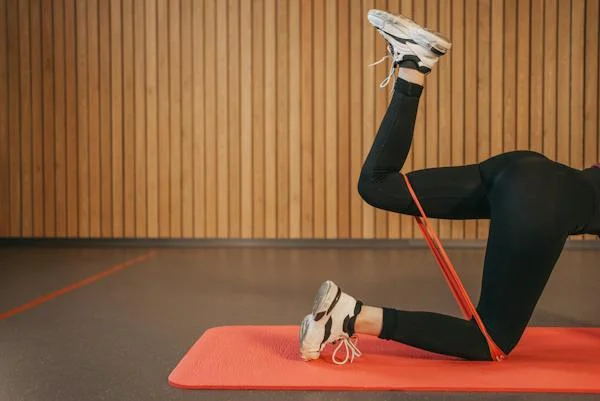
Frog Pumps Exercise
Frog pump exercises are ideal for leg workouts. This routine involves high repetition and low resistance, effectively targeting the glutes and inner thighs while enhancing definition in the area.
Despite their amusing name and appearance, Frog pumps are an excellent exercise to engage your glutes, whether used as a warm-up or cool-down at the start or end of your workout routine.
Benefits of Frog Pumps:
- Target Multiple Muscle Groups: Frog pumps effectively engage various lower-body muscles, including the glutes, core, and abductors, promoting comprehensive strength development throughout the hip area.
- Deep Gluteal Muscle Activation: These pumps work all three major gluteal muscles—the maximus, medius, and minimus—contributing to enhanced pelvic stability and lower body function. While the gluteus maximus is well-known, the medius and minimus play equally vital roles often overlooked in traditional workouts.
- Support Pelvic Strength and Stability: Incorporating frog pumps into your routine helps build gluteal strength and enhances overall balance by stabilizing the pelvic region. This stability boost contributes to a sculpted posterior, improves functional movement patterns, and reduces the risk of injury.
To perform frog pumps, lay on your back with your knees facing outward and join the soles of your feet, forming a diamond shape with your legs. Keep your arms by your sides. Engage your glutes, raise your hips off the ground, and lower them back to the starting position. If incorporating this exercise into your warm-up, aim for 15–20 reps. However, if using it as a conclusion to your workout, do as many reps as you can to fully engage your glutes and feel the burn.
Leg Kickbacks (Quadruped Hip Extension) Exercises
The quadruped hip extension, or the glute kickback, is a fantastic exercise for beginners to target the gluteus maximus. It allows you to engage each side of the body independently, making it practical for strengthening the glute muscles without the complexity of movements like squats or lunges. Individuals can build strength in their glutes by focusing on isolation exercises like the quadruped hip extension, especially if they find total-body compound movements challenging.
Benefits of the Quadruped Hip Extension:
The quadruped hip extension effectively targets the gluteus maximus and medius, the largest muscles in the buttocks, while also engaging the stabilizing muscles of the core to maintain a neutral spine from hips to shoulders. This dual focus strengthens the glutes, enhances core stability, and supports the lower back.
As an isolation exercise performed unilaterally, the quadruped hip extension uniquely activates the glute muscles, as demonstrated in research comparing it to other joint butt exercises like squats, lunges, step-ups, and leg presses. This exercise’s effectiveness in targeting the glutes makes it a valuable addition to a comprehensive workout routine.
While it’s advisable to incorporate various exercises, including squats, alongside the quadruped hip extension, this movement offers particular benefits for individuals with a limited range of motion or injuries that prevent them from performing traditional lower body exercises. Over time, improved glute strength from the quadruped hip extension can facilitate progress in compound movements like squats and lunges.
A glute kickback is a highly effective exercise typically performed on all fours, targeting the glute muscles, including the gluteus minimus, medius, and maximus. These muscles are vital in stabilizing the pelvis and lower back, supporting various movements like walking, squats, and deadlifts. The exercise enhances leg extension, muscle development, balance, and flexibility, offering versatility without additional equipment.
Correct form is crucial for optimizing the advantages and benefits of the exercise to prevent injury, emphasizing the importance of maintaining a straight back and avoiding lower back arching. By prioritizing correct form and gradually adjusting intensity factors such as tempo, reps, or resistance, individuals can ensure effective muscle activation and minimize the risk of injury, facilitating consistent progress and overall fitness improvement.
This light-intensity exercise enhances flexibility, stabilizes the core and lower back, and specifically targets the glutes.
To perform this exercise, begin in the quadruped position, with your hands aligned under your shoulders and knees under your hips, ensuring a neutral spine and engaged core. Lift your right knee off the ground, keeping your weight balanced, and extend your right leg backward and slightly upward, focusing on engaging your glutes without rotating your hips or shoulders. Return to the initial position to finish one repetition. Aim for 8–12 repetitions across 2–3 sets on each leg to maximize the effectiveness of the exercise.
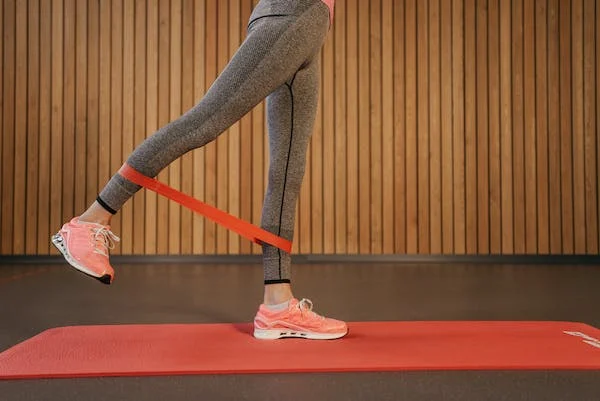
Lateral Band Walk
Lateral band walks are a straightforward yet efficient workout for strengthening and defining the legs and glutes. They entail wrapping a resistance band around the ankles and sidestepping while keeping the band taut.
The lateral band walk is an effective exercise that primarily engages your gluteus medius, commonly known as your side glutes. You can perform this exercise with or without a loop band. Maintain level hips and forward-facing feet throughout the movement. Focus on moving slowly and deliberately from side to side to maximize the effectiveness of the exercise, avoiding any bouncing motion with each step.
Engaging in lateral band walks offers numerous benefits for your lower body. This exercise effectively targets the gluteus maximus, medius, and minimus, strengthening these muscles while promoting stability in your knees and hips. By incorporating lateral band walks into your routine, following proper technique can reduce the likelihood of injury and enhance your lower body’s overall strength and functionality.
If you use a loop band, position it slightly above your knees. Stand with your feet separated at shoulder width and keep your knees slightly bent in a half-squat position stance. Transfer your weight to your right leg and take a comprehensive step to the left with your left leg. As you step sideways, bring your right leg in to return to the starting position. Repeat this movement for 8–10 steps. Then, repeat the sequence in the opposite direction until you return to your starting point, completing one set. Aim to perform 2–3 sets of this exercise.
Conclusion:
Butt-lifting exercises suit your body and health if you follow the technique correctly. Choose wisely according to the targeted muscles to which you want an enhancement. Prioritizing glute training enhances physical performance, reduces the risk of injury, and promotes overall functional fitness. Strong glutes are essential for optimal movement mechanics and power generation across various activities, making them a vital component of any fitness regimen.
